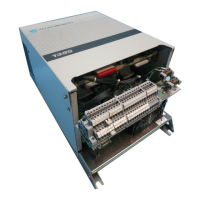Malfunctions Not Indicated by a Fault 3-11
Encoder Device Malfunction
Malfunction Symptom Solution
The drive faults on “VP-10
Feedback Loss”. This indicates
that the measured velocity from
the encoder is less than the
level programmed in parameter
732 “Tach Loss Vel” and the
velocity calculated from the
CEMF of the motor is greater
than the level programmed in
parameter 731 “Tach Loss
CEMF”.
The velocity feedback is not being
registered because jumpers on the Main
Control Board are selected incorrectly
for the encoder in use. Verify that the
jumper selection for the encoder output
voltage on the Main Control Board is
correct.
• For 5V differential encoders J8, J9, and J10 should be in
position 1-2. For 12V differential encoders J8-J10 should be in
position 2-3.
The encoder feedback device is
inoperative due to lack of encoder power
supply. Measure the encoder power
supply from the 1395 drive by measuring
from TB3-13 (+) to TB3-14 (-) with a
DVM. The voltage level should be +12V,
10%.
• If the supply is near zero remove all power to the drive.
Disconnect the encoder supply connections at TB3-13 and
TB3-14. Apply power and repeat the measurement. If the
supply is restored to its proper level the encoder power supply
foldback circuit was activated. Remove all power to the drive
and connect the supply connections to the encoder. If upon
applying power, the supply again folds back, excessive current
draw is occurring. This could be due to shorted supply
connections or a damaged encoder. Check all wiring between
the 1395 terminal strip and the encoder. If the wiring is
functional, replace the encoder.
If the supply remains low even after the encoder is disconnected,
replace the Main Control Board.
The encoder output signals are lost due
to a malfunction of the line drivers in the
encoder device.
• Measure the encoder output signals at the 1395 terminal strip.
Place a scope probe at TB3-17 and at TB3-18 and reference
them to TE. These signals represent the differential channel
outputs for phase B. TB3-17 is inverted and TB3-18 is
non-inverted. Rotate the shaft of the motor, either by
mechanical means or under armature voltage feedback
control. The resulting waveform should be similar to Waveform
3. If the proper signal is not observed, replace the encoder.
• Note: If using armature voltage feedback to troubleshoot the
encoder, the set-up procedure for armature voltage feedback
must be performed first for proper operation.
• Use the same method to check phase A of the encoder output.
Place a scope probe at TB3-19 and TB3-20 and reference
them to TE. TB3-19 is inverted and TB3-20 is non-inverted.
Rotate the shaft of the motor, either by mechanical means or
under armature voltage feedback control. The resulting
waveform should be similar to Waveform 3. If the proper signal
is not observed, replace the encoder.
The encoder output signals are present
at TB3, but the quadrature relationship is
incorrect between phases A and B.
• Open the drive door and lower the Main Control Board
assembly. Locate test points TP12 and TP15 on the left side of
the board near U13. TP12 is the phase B signal and TP15 is
the phase A. Verify that proper quadrature exists between A
and B. Rotate the motor in the CCW direction, as viewed from
the commutator. The resulting waveform should be similar to
Waveform 1 shown in Figure 3-1. If the encoder signals are in
phase or 180 Deg out of phase, check the wiring to ensure that
the signal lines are not shorted. If the wiring is functional
replace the encoder.
Encoder output signals present at TB3,
not present on Main Control Board.
Encoder interface failure.
• Replace the Main Control board.
Aotewell Ltd industry-mall.net

